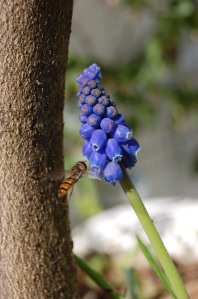Position: Full sun to partial shade
Soil: Moist, well drained
Flowering period: Spring
Eventual Height: 20cm
Eventual Spread: 5cm
Hardiness: 4a, 4b, 5a, 5b, 6a, 6b, 7a, 7b, 8a, 8b, 9a
Family: Hyacinthaceae
Muscari armeniacumalso is a vigorous, bulbous perennial that produces. Its mid green leaves are semi-erect, narrowly linear, lance shaped. It bears dense racemes of tubular bright blue/ purple flowers with constricted white mouths in spring which last for 3-4 weeks. The flowering stems are up to 15cm tall.
Muscari armeniacumalso known as the Grape Hyacinth or Armenian Grape Hyacinth, is native to the eastern Mediterranean. In its native habitat it grows in the dappled shade of woodlands and meadows.
The etymological root of the binomial name Muscari is from the Greek moschos meaning ‘musk’, in reference to certain species having flowers with a musky aroma. Armeniacum is derived from the Latin, in reference to its origins in Armenia.
Muscari armeniacumalso is useful to the landscape architect for its spring colour and can be used to create swathes of flowers sweeping across the ground. It is a useful bulb to naturalize under the canopy of trees as this bulb usually flower and photosynthesize before the tree comes into leaf.
Muscari armeniacumalso is ecologically valuable as it attracts insects that feed on its pollen and nectar including the Syrphidae or hover-fly family (pictured), whose larvae prey on pest insect species such as aphids.
The Royal Horticultural Society have given Muscari armeniacumalso their prestigious Award of Garden Merit.
Muscari armeniacumalso prefers moist, well-drained soils. It tolerates most pH of soil
Muscari armeniacumalso requires little to no care, flower spikes may be removed when the have finished flowering and dead material can be removed in autumn. Large clumps may be divided in early autumn or when the leaves begin to wither.







Leave a comment